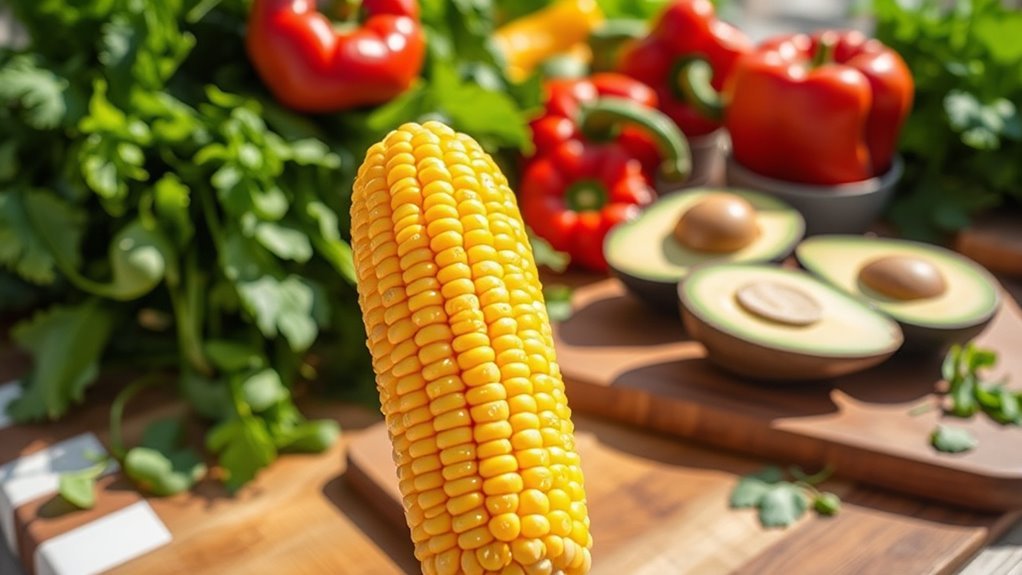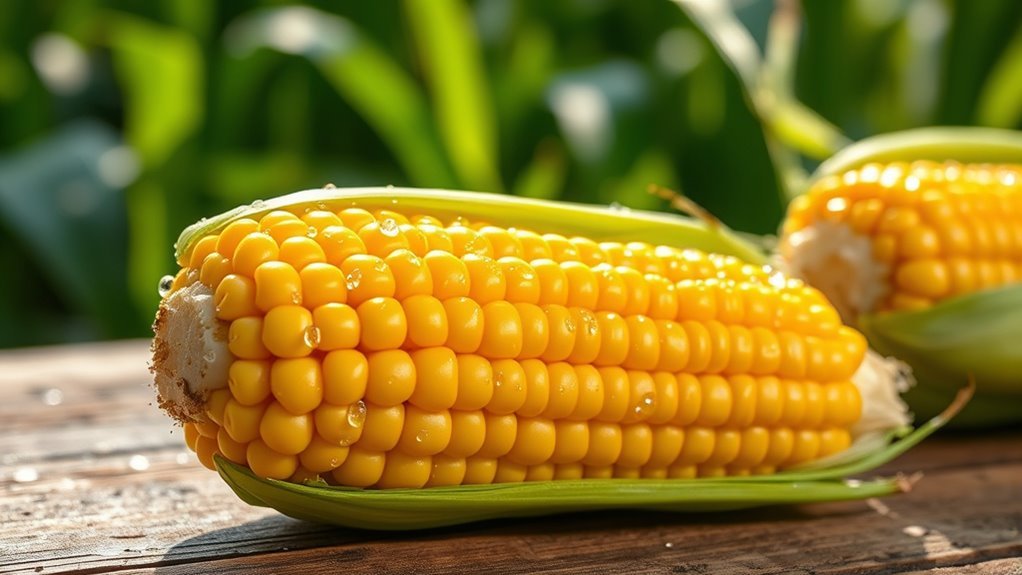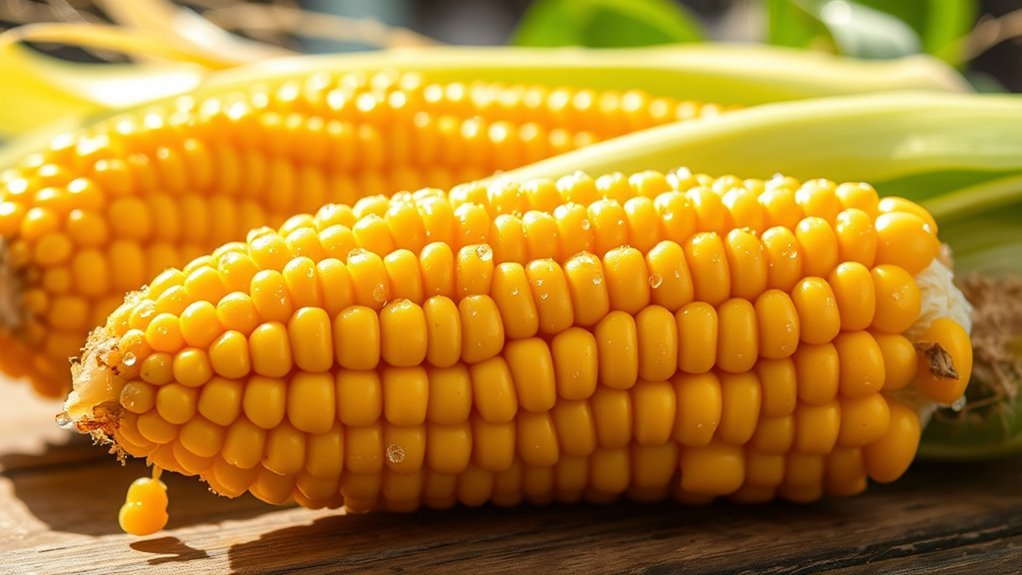Corn isn’t typically compatible with a ketogenic diet due to its high carbohydrate content, which can disrupt your ability to maintain ketosis. A cup of cooked corn contains around 25 grams of carbs, making it a challenging choice for keto. While it offers some nutritional benefits, its glycemic load can spike insulin levels, promoting fat storage rather than fat burning. Understanding your options can help you make informed choices on this journey. There’s more to explore on making keto-friendly selections.
Understanding the Ketogenic Diet

While many diets focus on calorie counting or food restrictions, the ketogenic diet emphasizes a significant shift in macronutrient intake, primarily reducing carbohydrates and increasing fats. At its core, the keto principles revolve around achieving a state of fat adaptation, where your body becomes efficient at burning fat for fuel instead of glucose. By drastically lowering your carb intake, you encourage your body to enter ketosis, a metabolic state that can lead to weight loss and increased energy levels. This approach allows you to enjoy a variety of high-fat foods, offering a sense of freedom in your dietary choices. Understanding these principles can empower you to make informed decisions about your eating habits, revealing a healthier lifestyle without feeling deprived.
Nutritional Profile of Corn

Although corn is often celebrated for its versatility and taste, its nutritional profile may not align well with ketogenic principles. Different corn varieties, such as sweet corn and popcorn, offer varying health benefits, including fiber and vitamins. For instance, sweet corn is rich in antioxidants, which can support overall health. However, it’s essential to recognize that these benefits come alongside a higher carbohydrate content, which can hinder your keto goals. If you’re exploring a low-carb lifestyle, you’ll want to be cautious about how corn fits into your diet. While it can provide essential nutrients, moderation is key. Balancing enjoyment of corn with your dietary needs allows for a more flexible approach to nutrition while pursuing your health objectives.
Carbohydrate Content in Corn

Corn contains approximately 25 grams of carbohydrates per cup when cooked, making it a significant source of carbs in a typical serving. Different corn varieties, like sweet corn and cornmeal, can vary in carb content, but they generally remain high compared to other vegetables. If you’re following a keto diet, you might find it challenging to incorporate corn without exceeding your daily carb limit. While you can experiment with keto recipes that use corn in moderation, be mindful of portion sizes. You could consider alternatives like cauliflower or zucchini, which are lower in carbs. Ultimately, being aware of corn’s carbohydrate content can help you make informed choices that align with your dietary goals while still enjoying a variety of flavors.
Impact of Corn on Ketosis
When considering corn’s impact on ketosis, it’s important to analyze its carbohydrate content and glycemic index. High-carb foods can hinder your ability to maintain ketosis, making it vital to explore alternatives that better fit a low-carb lifestyle. Understanding these factors will help you make informed choices about what to include in your diet.
Carbohydrate Content Analysis
The carbohydrate content of corn plays a crucial role in determining its suitability for a ketogenic diet. While corn isn’t typically keto-friendly, understanding its varieties and fiber content can help you make informed choices. Here are a few key points to evaluate:
- Sweet Corn: Contains about 25 grams of carbs per cup, making it a higher-carb option.
- Popcorn: Offers roughly 30 grams of carbs per 3 cups, with some fiber benefits.
- Cornmeal: Has around 73 grams of carbs per cup, making it more suitable for occasional indulgence.
- Fiber Content: Corn does provide fiber, which can help mitigate some carb effects, but it’s still important to track your intake.
With these insights, you can better navigate your keto journey while enjoying the occasional corn-based treat.
Glycemic Index Considerations
Although many people enjoy corn for its sweet taste and versatility, its glycemic index (GI) is an important factor to take into consideration if you’re aiming to maintain ketosis. Corn has a relatively high glycemic load, which can lead to a significant insulin response. This spike in insulin can hinder your ability to stay in ketosis, as elevated insulin levels promote fat storage over fat burning. While it’s tempting to include corn in your meals, it’s important to reflect on how it might affect your overall carb intake and blood sugar levels. If you’re committed to a ketogenic lifestyle, monitoring the impact of foods like corn on your glycemic response is vital for achieving your health goals.
Alternatives to Corn
If you’re looking for alternatives to corn that won’t disrupt your ketosis, there are several low-carb options worth considering. Here are some tasty substitutes:
- Zucchini noodles – A great pasta alternative, they’re low in carbs and versatile.
- Cauliflower rice – This can replace grains and adds a nice texture to meals.
- Bell pepper – Use them for stuffing or as a crunchy snack; they’re low in carbs and high in nutrients.
- Mushroom caps – These can be grilled or filled for a savory option that’s both satisfying and keto-friendly.
Other options include spaghetti squash, broccoli florets, cabbage slaw, eggplant slices, celery sticks, and radish chips. These choices will keep your meals exciting while maintaining your keto lifestyle!
Types of Corn and Their Carbs
When you’re managing a ketogenic diet, it’s essential to understand the different types of corn and their carbohydrate content. Here’s a quick overview that can help you make informed choices:
| Type of Corn | Carbs per 100g | Common Uses |
|---|---|---|
| Sweet Corn | 19g | Corn tortillas, corn salsa |
| Field Corn | 74g | Corn meal, corn oil |
| Popcorn Varieties | 78g | Snacks, cornflakes |
Sweet corn contains fewer carbs than field corn, making it a better choice for keto. Popcorn varieties are high in carbs, so they might not fit your dietary needs. Avoid processed items like corn syrup and corn starch, as they can derail your keto goals.
Corn vs. Other Vegetables on Keto
While sweet corn may be a better option for those on a ketogenic diet compared to field corn and popcorn, it’s important to compare its nutritional profile with other low-carb vegetables. Here are some vegetable comparisons to evaluate:
- Spinach: Only 1g net carbs per cup, packed with nutrients.
- Zucchini: About 2g net carbs per cup, versatile for various dishes.
- Broccoli: Roughly 4g net carbs per cup, high in fiber and vitamins.
- Cauliflower: Approximately 3g net carbs per cup, a great rice substitute.
When looking at corn varieties, sweet corn may fit into your keto plan occasionally, but these low-carb vegetables offer better options for staying in ketosis while providing essential nutrients.
Ways to Enjoy Corn Mindfully
Enjoying corn mindfully on a ketogenic diet means savoring its unique taste while being aware of your carbohydrate intake. You can incorporate corn thoughtfully into your meals by using it in moderation. Try experimenting with corn recipes that balance flavors while keeping carbs in check, such as corn salsa or a fresh corn salad with plenty of leafy greens. Mindful eating involves paying attention to how corn affects your body and appetite. Take time to enjoy each bite, and pair it with high-fat, low-carb ingredients to maintain ketosis. By being intentional about portion sizes and preparation methods, you can relish corn’s sweetness without derailing your diet. Embrace the freedom to enjoy corn, but do so with awareness.
Keto-Friendly Alternatives to Corn
If you’re looking to replace corn in your meals while staying within the bounds of a keto diet, there are several great alternatives to contemplate. These keto substitutes can help you maintain a low-carb lifestyle while still enjoying satisfying dishes.
- Cauliflower Rice – A versatile and popular option, perfect for stir-fries or as a side dish.
- Zucchini Noodles – Great for replacing pasta in dishes like spaghetti squash recipes.
- Mushroom Caps – Use them as a base for pizzas or stuffed with savory ingredients.
- Leafy Greens – Ideal for salads or wraps, offering a nutrient-rich, low-carb option.
Incorporate these alternatives into your meals for delicious, keto-friendly dishes that keep your carb count low!
Tips for Staying Within Your Carb Limit
To successfully stay within your carb limit on a keto diet, it’s essential to be mindful of your food choices and portion sizes. Begin with effective meal planning; outline your meals for the week, ensuring you include low-carb options. This not only helps in choosing the right ingredients but also prevents impulse eating. Practice portion control by measuring servings, especially for foods that can quickly add up in carbs. Incorporate more leafy greens and non-starchy vegetables to fill your plate without exceeding your limits. Remember, tracking your daily carb intake can provide valuable insights, allowing you to adjust as needed. By being intentional about what you eat, you can enjoy a satisfying and sustainable keto lifestyle without feeling deprived.
Final Thoughts on Corn and Keto
When considering corn on a keto diet, it’s crucial to analyze its carb content, as it can add up quickly. You might want to explore alternatives that are lower in carbs to stay within your daily limits. Balancing your choices can help you maintain ketosis while still enjoying a variety of flavors.
Carb Content Analysis
Steering through the world of keto can be tricky, especially when it comes to understanding the carb content of various foods. When examining corn varieties, it’s essential to evaluate how they stack up against your keto goals. Here are some carb comparisons:
- Sweet Corn: About 25 grams of carbs per cup.
- Corn on the Cob: Roughly 30 grams of carbs per medium ear.
- Popcorn: Approximately 30 grams of carbs per 3 cups (popped).
- Cornmeal: Around 73 grams of carbs per cup.
While corn does provide fiber and nutrients, its higher carb content can make it challenging to fit into a strict keto diet. Understanding these values allows you to make informed choices that align with your dietary freedom.
Alternatives to Corn
Given the significant carb content in various types of corn, exploring alternatives can be beneficial for those adhering to a keto diet. You might enjoy zucchini noodles or cauliflower rice as low-carb substitutes that add texture to your meals. Bell pepper can serve as a crunchy addition to salads or as a vessel for stuffing. For a satisfying side, try radish fries or kale chips. Spaghetti squash is great for pasta dishes, while mushroom caps can be filled with your favorite toppings. Eggplant slices can mimic bread or be layered in casseroles. Don’t forget about a revitalizing avocado salad or using cabbage wraps for a hearty sandwich. These alternatives can keep your meals exciting while staying within your carb limits.


